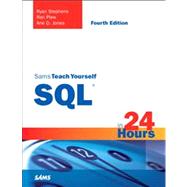
What is included with this book?
For more than 10 years, the authors have studied, applied, and documented the SQL standard and its application to critical database systems in this book. Ryan Stephens and Ron Plew are entrepreneurs, speakers, and cofounders of Perpetual Technologies, Inc. (PTI), a fast-growing IT management and consulting firm. PTI specializes in database technologies, primarily Oracle and SQL servers running on all Unix, Linux, and Microsoft platforms. Starting out as data analysts and database administrators, Ryan and Ron now lead a team of impressive technical subject matter experts who manage databases for clients worldwide. They authored and taught database courses for Indiana University-Purdue University in Indianapolis for five years and have authored more than a dozen books on Oracle, SQL, database design, and high availability of critical systems.
Arie D. Jones is Senior SQL Server database administrator and analyst for Perpetual Technologies, Inc. (PTI) in Indianapolis, Indiana. Arie leads PTI’s team of experts in planning, design, development, deployment, and management of database environments and applications to achieve the best combination of tools and services for each client. He is a regular speaker at technical events and has authored several books and articles pertaining to database-related topics. The most recent is SQL Functions Programmer’s Reference from Wrox Publishing.
| Introductionnbsp | p. 1 |
| What This Book Intends to Accomplish | p. 1 |
| What We Added to This Edition | p. 1 |
| What You Need | p. 2 |
| Conventions Used in This Book | p. 2 |
| ANSI SQL and Vendor Implementations | p. 3 |
| Understanding the Examples and Exercises | p. 3 |
| A SQL Concepts Overview | |
| Welcome to the World of SQL | p. 7 |
| SQL Definition and History | p. 7 |
| SQL Sessions | p. 14 |
| Types of SQL Commands | p. 15 |
| The Database Used in This Book | p. 17 |
| Summary | p. 22 |
| Q&A | p. 23 |
| Workshop | p. 24 |
| Building Your Database | |
| Defining Data Structures | p. 27 |
| What Is Data? | p. 27 |
| Basic Data Types | p. 28 |
| Summary | p. 36 |
| Q&A | p. 37 |
| Workshop | p. 37 |
| Managing Database Objects | p. 41 |
| What Are Database Objects? | p. 41 |
| What Is a Schema? | p. 42 |
| A Table: The Primary Storage for Data | p. 44 |
| Integrity Constraints | |
| Table of Contents provided by Publisher. All Rights Reserved. |
The New copy of this book will include any supplemental materials advertised. Please check the title of the book to determine if it should include any access cards, study guides, lab manuals, CDs, etc.
The Used, Rental and eBook copies of this book are not guaranteed to include any supplemental materials. Typically, only the book itself is included. This is true even if the title states it includes any access cards, study guides, lab manuals, CDs, etc.